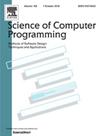Grits:一种基于半公理序列演算的消息传递编程语言
IF 1.4
4区 计算机科学
Q3 COMPUTER SCIENCE, SOFTWARE ENGINEERING
引用次数: 0
摘要
Grits是一种基于信道的消息传递并发语言,它基于半公理序列演算,是支持直觉会话类型的逻辑基础。该语言利用伴随逻辑的模态来表达许多编程习惯用法,如广播通信和消息取消。Grits解释器是用Go语言开发的,主要由两个组件组成:类型检查器和求值器。本文章由计算机程序翻译,如有差异,请以英文原文为准。
Grits: A message-passing programming language based on the semi-axiomatic sequent calculus
This paper introduces Grits, a channel-based message-passing concurrent language based on the semi-axiomatic sequent calculus, a logical foundation underpinning intuitionistic session types. The language leverages modalities from adjoint logic to express a number of programming idioms such as broadcast communication and message cancellation. The Grits interpreter is developed using Go, and consists primarily of two components: a type-checker and an evaluator.
求助全文
通过发布文献求助,成功后即可免费获取论文全文。
去求助
来源期刊

Science of Computer Programming
工程技术-计算机:软件工程
CiteScore
3.80
自引率
0.00%
发文量
76
审稿时长
67 days
期刊介绍:
Science of Computer Programming is dedicated to the distribution of research results in the areas of software systems development, use and maintenance, including the software aspects of hardware design.
The journal has a wide scope ranging from the many facets of methodological foundations to the details of technical issues andthe aspects of industrial practice.
The subjects of interest to SCP cover the entire spectrum of methods for the entire life cycle of software systems, including
• Requirements, specification, design, validation, verification, coding, testing, maintenance, metrics and renovation of software;
• Design, implementation and evaluation of programming languages;
• Programming environments, development tools, visualisation and animation;
• Management of the development process;
• Human factors in software, software for social interaction, software for social computing;
• Cyber physical systems, and software for the interaction between the physical and the machine;
• Software aspects of infrastructure services, system administration, and network management.
 求助内容:
求助内容: 应助结果提醒方式:
应助结果提醒方式:


